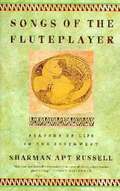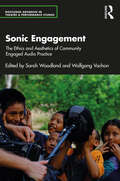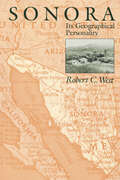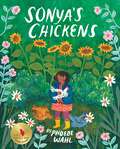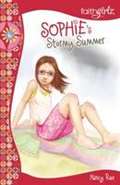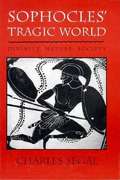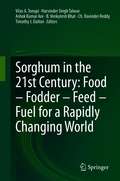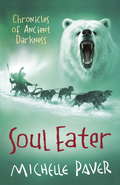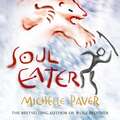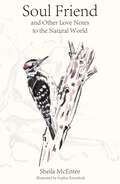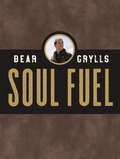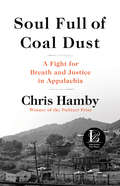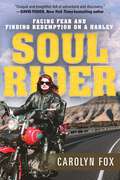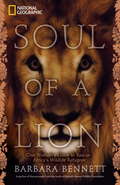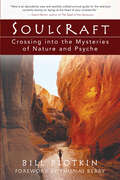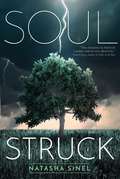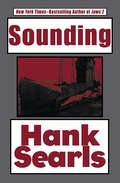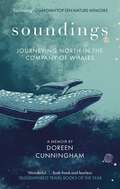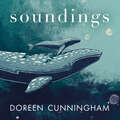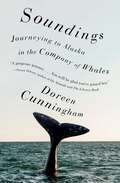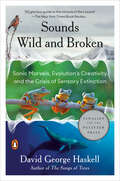- Table View
- List View
Songs of the Fluteplayer: Seasons of Life in the Southwest
by Sharman Apt RussellFrom the flooding of southern New Mexico's Mimbres River in the summer, to the year-round search for community in rural America, Sharman Apt Russell recounts her experiences in creating a life for herself and her family.
Sonic Engagement: The Ethics and Aesthetics of Community Engaged Audio Practice (Routledge Advances in Theatre & Performance Studies)
by Sarah Woodland Wolfgang VachonSonic Engagement examines the relationship between community engaged participatory arts and the cultural turn towards audio, sound, and listening that has been referred to as the 'sonic turn'. This edited collection investigates the use of sound and audio production in community engaged participatory arts practice and research. The popularity of podcast and audio drama, combined with the accessibility and portability of affordable field recording and home studio equipment, makes audio a compelling mode of participatory creative practice. This book maps existing projects occurring globally through a series of case study chapters that exemplify community engaged creative audio practice. The studies focus on audio and sound-based arts practices that are undertaken by artists and arts-led researchers in collaboration with (and from within) communities and groups. These practices include—applied audio drama, community engaged podcasting, sound and verbatim theatre, participatory sound art, community-led acoustic ecology, sound and media walks, digital storytelling, oral history and reminiscence, and radio drama in health and community development. The contributors interrogate the practical, political, and aesthetic potentialities of using sound and audio in community engaged arts practice, as well as its tensions and possibilities as an arts-led participatory research methodology. This book provides the first extensive analysis of what sound and audio brings to participatory, interdisciplinary, arts-led approaches, representing a vital resource for community arts, performance practice, and research in the digital age.
Sonora: Its Geographical Personality
by Robert C. WestThis cultural and historical geography of Sonora explores the region&’s dual personality—with modern life existing alongside its colonial past.A land where some streams ran with gold. A landscape nearly empty of inhabitants in the wake of Apache raids from the north. And a former desert transformed by irrigation into vast fields of wheat and cotton. This was and is the state of Sonora in northwest Mexico.Robert C. West explores the dual geographic "personality" of this part of Mexico's northern frontier. Utilizing the idea of "old" and "new" landscapes, he describes two Sonoras—to the east, a semiarid to subhumid mountainous region that reached its peak of development in the colonial era; and, to the west, a desert region that has become a major agricultural producer and the modern center of economic and cultural activity. After a description of the physical and biotic aspects of Sonora, West describes the aboriginal farming cultures that inhabited eastern Sonora before the Spanish conquest. He then traces the spread of Jesuit missions and Spanish mining and ranching communities. He charts the decline of eastern Sonora with the coming of Apache and Seri raids during the eighteenth and nineteenth centuries. And he shows how western Sonora became one of Mexico's most powerful political and economic entities in the twentieth century.
Sonora: Its Geographical Personality
by Robert C. WestThis cultural and historical geography of Sonora explores the region&’s dual personality—with modern life existing alongside its colonial past.A land where some streams ran with gold. A landscape nearly empty of inhabitants in the wake of Apache raids from the north. And a former desert transformed by irrigation into vast fields of wheat and cotton. This was and is the state of Sonora in northwest Mexico.Robert C. West explores the dual geographic "personality" of this part of Mexico's northern frontier. Utilizing the idea of "old" and "new" landscapes, he describes two Sonoras—to the east, a semiarid to subhumid mountainous region that reached its peak of development in the colonial era; and, to the west, a desert region that has become a major agricultural producer and the modern center of economic and cultural activity. After a description of the physical and biotic aspects of Sonora, West describes the aboriginal farming cultures that inhabited eastern Sonora before the Spanish conquest. He then traces the spread of Jesuit missions and Spanish mining and ranching communities. He charts the decline of eastern Sonora with the coming of Apache and Seri raids during the eighteenth and nineteenth centuries. And he shows how western Sonora became one of Mexico's most powerful political and economic entities in the twentieth century.
Sons of Alba
by Blandine P. MartinOn the verge of death, the Chief of Clan MacLeod of Skye confessed to his sons - Rhys, Kai and Scott - that they had a hidden sister, Effie. Worried about the sudden disappearance of her lassie, and frustrated by the futility of the ongoing researches, he implored his sons to go out in search of their lost younger sister in the hope of discharging his responsibility while there was still time. With a brave heart and out of gratitude to their clan chief and their father as well, the MacLeod brothers set off on a journey across the Isle of Skye. Their world view could well be turned upside down through multiple bizarre encounters in the lands of their ancestors. In the course of tracing their family secret, the MacLeod brothers set out on an adventure that will change them forever. What if opening up for the future was the only way to heal from the past?
Sons of Salt
by Yaccaira SalvatierraVolcanic eruptions and waves collide in Yaccaira Salvatierra’s explosive debut collection Sons of Salt, which explores the duality of personal and political landscapes as well as legacies of violence within Mexican-American communities.Sons of Salt poignantly captures the experiences of mothers who battle for their sons’ wellbeing, particularly when fathers are absent due to systemic oppressions.Salvatierra’s verse breaks the bones of poetic form to bring attention to the failures of a conceptually western God who has categorically failed to protect His children, and gives birth instead to a god of nature.Weaving self-made mythology, mourning, and maternal fear into visual and narrative poems, Salvatierra creates a collection that probes the deepest hurt to ensure the holiest redemption.
Sonya's Chickens
by Phoebe WahlA beautifully told story about love, loss and the circle of life. Warm, nostalgic illustrations capture the earthy feel of this book about a little girl's chicken who is stolen by a fox. Sonya raises her three chickens from the time they are tiny chicks. She feeds them, shelters them and loves them. Everywhere Sonya goes, her chicks are peeping at her heels. Under her care, the chicks grow into hens and even give Sonya a wonderful gift: an egg! One night, Sonya hears noises coming from the chicken coop and discovers that one of her hens has disappeared. Where did the hen go? What happened to her? When Sonya discovers the answers, she learns some important truths about the interconnectedness of nature and the true joys and sorrows of caring for another creature.
Sophie's Stormy Summer
by Nancy RueFiona's family is spending a week at Virginia Beach with all the Corn Flakes and Fiona's new French nanny when it's discovered that Kitty has leukemia. Sophie wants to shave her head in solidarity with Kitty, and soon learns that she must do what God calls her to do, no matter how hard.
Sophocles' Tragic World: Divinity, Nature, Society
by Charles SegalIn a series of engagingly written interconnected essays, Segal studies five of Sophocles' seven extant plays: Ajax, Oedipus Tyrannus, Philoctetes, Antigone, and the often neglected Trachinian Women.
Sorghum in the 21st Century: Food – Fodder – Feed – Fuel for a Rapidly Changing World
by Timothy J. Dalton Vilas A. Tonapi Harvinder Singh Talwar Ashok Kumar Are B. Venkatesh Bhat Ch. Ravinder ReddySorghum is the most important cereal crop grown in the semi-arid tropics (SAT) of Africa, Asia, Australia and Americas for food, feed, fodder and fuel. It is the fifth most important cereal crop globally after rice, wheat, maize and barley, and plays a major role in global food security. Sorghum is consumed in different forms for various end-uses. Its grain is mostly used directly for food purposes. After the release of the proceedings of two international symposia in the form of books “Sorghum in Seventies” and “Sorghum in Eighties”, global sorghum research and development have not been documented at one place. Of course, few books on sorghum have been released that focus on specific issues/research areas, but comprehensive review of all aspects of recent development in different areas of sorghum science has not been compiled in the form a single book. This book is intended to fill in a void to bridge the gap by documenting all aspects of recent research and development in sorghum encompassing all the progress made, milestones achieved across globe in genetic diversity assessment, crop improvement and production, strategies for high yield, biotic and abiotic stress resistance, grain and stover quality aspects, storage, nutrition, health and industrial applications, biotechnological applications to increase production, including regional and global policy perspectives and developmental needs. This book will be an institutional effort to compile all the latest information generated in research and development in sorghum across the globe at one place.
Soul Eater: Book 3 from the bestselling author of Wolf Brother (Chronicles of Ancient Darkness #3)
by Michelle PaverA boy. A wolf. A legend for all time. The third book in the internationally bestselling WOLF BROTHER (Chronicles of Ancient Darkness) series by renowned author Michelle Paver.Torak has survived the summer and his heartstopping adventure in the Seal Islands. He and Wolf are together once more. But their reunion is short-lived.As mid winter approaches, Torak learns that Wolf has been snatched. In a desperate bid to rescue him, Torak and Renn must brave the frozen wilderness of the Far North and step into a world of deceit, treachery and lies, coming face to face with a terrifying evil. Another step is taken on his quest to destroy the Soul-Eaters, but with it comes the burden of an utterly chilling secret of his own ...Audio edition also available, read by Sir Ian McKellen.
Soul Eater: Book 3 from the bestselling author of Wolf Brother (Chronicles of Ancient Darkness #3)
by Michelle PaverA boy. A wolf. A legend for all time. The third book in the internationally bestselling WOLF BROTHER (Chronicles of Ancient Darkness) series by renowned author Michelle Paver. Audio edition read by Sir Ian McKellen.Torak has survived the summer and his heartstopping adventure in the Seal Islands. He and Wolf are together once more. But their reunion is short-lived.As mid winter approaches, Torak learns that Wolf has been snatched. In a desperate bid to rescue him, Torak and Renn must brave the frozen wilderness of the Far North and step into a world of deceit, treachery and lies, coming face to face with a terrifying evil.Another step is taken on his quest to destroy the Soul-Eaters, but with it comes the burden of an utterly chilling secret of his own ...
Soul Eater: Book 3 from the bestselling author of Wolf Brother (Chronicles of Ancient Darkness #3)
by Michelle PaverA boy. A wolf. A legend for all time. The third book in the internationally bestselling WOLF BROTHER (Chronicles of Ancient Darkness) series by renowned author Michelle Paver.Torak has survived the summer and his heartstopping adventure in the Seal Islands. He and Wolf are together once more. But their reunion is short-lived.As mid winter approaches, Torak learns that Wolf has been snatched. In a desperate bid to rescue him, Torak and Renn must brave the frozen wilderness of the Far North and step into a world of deceit, treachery and lies, coming face to face with a terrifying evil. Another step is taken on his quest to destroy the Soul-Eaters, but with it comes the burden of an utterly chilling secret of his own ...Audio edition also available, read by Sir Ian McKellen.
Soul Friend: And Other Love Notes to the Natural World
by Sheila McEnteeIn Soul Friend and Other Love Notes to the Natural World, author and naturalist Sheila McEntee artfully conveys her deep love of the natural world and the solace she finds there. In twelve brief personal essays, spanning 20 years, she explores the flora and fauna in Appalachian forests, on the shores of the Potomac River, and, especially, in her own backyard, as she navigates the joys and trials of an introspective life: love, loss, death, loneliness, intimacy, uncertainty, and, ultimately, self-knowing and self-acceptance. In this small volume, we learn that nature teaches resiliency, and to be present to it is to find joy. Indeed, there is no heartache or struggle for which it does not offer comfort.
Soul Fuel: Daily Devotions to Survive the Adventure of Life (A 365-Day Devotional)
by Bear GryllsFind courage for the great adventure of life with this 365-day devotional that reminds you God is always there to hold you, guide you, strengthen you, and rescue you.Bestselling author Bear Grylls is best known for his seven seasons on National Geographic's Man vs. Wild, his current TV series, Running Wild with Bear Grylls, and his adventures climbing ice cliffs, running through forest fires, and parachuting from balloons. In Soul Fuel, Bear shares the backstories behind many of his most daring expeditions and how his faith gave him the purpose and power to carry on. In 365 devotions he explores themes of hope, courage, risk, heaven, and more. Nature has taught Bear some important lessons, and behind every feat is a story of grit, determination, and strength found in faith. As you read Soul Fuel, you will discover:How to find joy during the most difficult timesThe importance of hope and taking risksHow to create courage despite anxiety and fear Soul Fuel is perfect for:Men and womenSelf-purchase or a gift for anyone wanting to deepen their faithFans of Bear's TV series and those who love to read about survival Bear wants others to know, "I often don't feel very strong. Life can be a battle. We all feel that from time to time. But any strength I do have seems to come in the quiet moments at the start of my day. It comes when I am on my own, on my knees. It comes from taking time to be still with God. . . . So for me, starting my day like this really helps. It is like food. Like good fuel for the soul."Whether you are feeling strong, weak, underprepared, or just trying to survive until the end of the week, Soul Fuel will equip you to face the great adventure of life with the confidence of knowing that God is always there for you.
Soul Full of Coal Dust: A Fight for Breath and Justice in Appalachia
by Chris HambyIn a devastating and urgent work of investigative journalism, Pulitzer Prize winner Chris Hamby uncovers the tragic resurgence of black lung disease in Appalachia, its Big Coal cover-up, and the resilient mining communities who refuse to back down. Decades ago, a grassroots uprising forced Congress to enact long-overdue legislation designed to virtually eradicate black lung disease and provide fair compensation to coal miners stricken with the illness. Today, however, both promises remain unfulfilled. Levels of disease have surged, the old scourge has taken an aggressive new form, and ailing miners and widows have been left behind by a dizzying legal system, denied even modest payments and medical care. In this devastating and urgent work of investigative journalism, Pulitzer Prize winner Chris Hamby traces the unforgettable story of how these trends converge in the lives of two men: Gary Fox, a black lung-stricken West Virginia coal miner determined to raise his family from poverty, and John Cline, an idealistic carpenter and rural medical clinic worker who becomes a lawyer in his fifties. Opposing them are the lawyers at the coal industry&’s go-to law firm; well-credentialed doctors who often weigh in for the defense, including a group of radiologists at Johns Hopkins; and Gary&’s former employer, Massey Energy, the region&’s largest coal company, run by a cantankerous CEO often portrayed in the media as a dark lord of the coalfields. On the line in Gary and John&’s longshot legal battle are fundamental principles of fairness and justice, with consequences for miners and their loved ones throughout the nation. Taking readers inside courtrooms, hospitals, homes tucked in Appalachian hollows, and dusty mine tunnels, Hamby exposes how coal companies have not only continually flouted a law meant to protect miners from deadly amounts of dust but also enlisted well-credentialed doctors and lawyers to help systematically deny much-needed benefits to miners. The result is a legal and medical thriller that brilliantly illuminates how a band of laborers — aided by a small group of lawyers, doctors and lay advocates, often working out of their homes or in rural clinics and tiny offices – challenged one of the world's most powerful forces, Big Coal, and won. A deeply troubling yet ultimately triumphant work, Soul Full of Coal Dust is a necessary and timely book about injustice and resistance.
Soul Rider: Facing Fear and Finding Redemption on a Harley
by Carolyn FoxThis is the story of a woman who went on an incredible journey. Carolyn Fox was a single mother and lawyer haunted with grief and secrets, and facing her fiftieth birthday. So she decided to change her life by facing her fears: she bought a Harley, packed it with a sleeping bag and tent, and set out to ride through all fifty states-alone! Soul Rider is her gripping travel/journey memoir, written by a successful woman who realized she would have to make significant changes in the way she lived and thought, if she ever had a chance to find peace and wholeness. Soul Rider will inspire readers to:Believe they can improve the quality of their lives by stepping outside their comfort zonesFind the courage to ask for forgiveness - first by forgiving others, and then by forgiving themselvesRecognize that loneliness can be overcome, simply by being the first to say HelloLearn that it’s okay to admit failures, fears, and guilt. Stuff happens to everyone. Confront those things and discover how quickly personal empowerment flows.Along the way, Carolyn traveled alone but met colorful characters, received positive media attention, discovered who she was, and put more than 14,000 miles on her bike. She kept a journal of her adventures, and the result is Soul Rider.
Soul of a Lion: One Woman's Quest to Rescue Africa's Wildlife Refugees
by Barbara BennettIt chronicles the unique Harnas Wildlife Foundation in Namibia, where Marieta van der Merwe and her family, former wealthy cattle farmers, have sold land to buy and care for embattled wildlife.
Soulcraft: Crossing into the Mysteries of Nature and Psyche
by Bill PlotkinSince 1980, depth psychologist Bill Plotkin has been guiding women and men into the wilderness — the redrock canyons and snow-crested mountains of the American West — but also into the wilds of the soul. He calls this work soulcraft. There’s a great longing in all people to uncover the secrets and mysteries of our individual lives, to find the unique gift we were born to bring to our communities, and to experience our full membership in the more-than-human world. This journey to soul is a descent into layers of the self much deeper than personality, a journey meant for each one of us, not just for the heroes and heroines of mythology. A modern handbook for the journey, Soulcraft is not an imitation of indigenous ways, but a contemporary nature-based approach born from wilderness experience, the traditions of Western culture, and the cross-cultural heritage of all humanity. Filled with stories, poems, and guidelines, Soulcraft introduces over 40 practices that facilitate the descent to soul, including dreamwork, wilderness vision fasts, talking across the species boundaries, council, self-designed ceremony, nature-based shadow work, and the arts of romance, being lost, and storytelling.
Soulstruck
by Natasha SinelSeventeen-year-old Rachel Ferguson is trying to get struck by lightning. Hopefully it will lead to finding her soul mate, like it did for her mother. And then maybe her mom will be as devoted to her as she is to her lightning strike survivors group.When Rachel discovers letters written by her mother's soul mate-the man she thought was her father-she begins to question everything she's always believed, including soul mates, fate, and even her mother. No longer sure of its power, she decides to quit chasing lightning.Rachel feels abandoned and alone-her best friend has ditched her, her boyfriend has dumped her, and a confrontation with her mom only made things worse. At least she still has her friend Jay-in fact, their growing attraction to each other seems to be the only good thing happening.But when her relationship with Jay starts to unravel, too, the impulse to get struck by lightning resurfaces. And there's a thunderstorm coming.Set in Wellfleet, Cape Cod, in the off-season, Soulstruck is about the search for love and the risk of losing it while waiting for destiny to happen.
Sounding
by Hank SearlsA New York Times–bestselling author&’s intricately conceived, &“remarkably eloquent&” response to Moby-Dick: a story of harmony between man and whale (The Washington Post). This unique adventure tale follows two characters: one a sonar officer aboard a sinking Russian nuclear submarine; the other a massive, aging sperm whale swimming nearby. As the young man spends what may be his last days with the ship&’s lovely surgeon, he listens to the plaintive calls of the whales sounding—calls of compassion, fear, and anger at humankind&’s attacks on his species. Little does he realize these fellow creatures may also provide his only hope of survival. Giving voice to these magnificent mammals, Hank Searls—who in addition to his work as a writer has also been a yachtsman, underwater photographer, and Navy flyer—taps into our ancient connection to the natural world in a fascinating, suspenseful, and provocative drama.
Soundings: Journeys in the Company of Whales
by Doreen Cunningham'A THRILLING, PASSIONATE AND TENDERHEARTED ADVENTURE' HELEN JUKES, AUTHOR OF A HONEYBEE HEART HAS FIVE OPENINGS'WHAT A VOICE! WHAT A BOOK!' CHARLES FOSTER, AUTHOR OF BEING A HUMAN'BEAUTIFUL AND BRAVE, AND STARTLING IN ITS RAW HONESTY' NEIL ANSELL, AUTHOR OF DEEP COUNTRYFrom the lagoons of Mexico to Arctic glaciers, grey whale mothers are swimming with their calves, past predatory orcas, through a warming sea. For ten thousand miles, they endure one of the longest mammalian migrations on the planet. Following them, by bus, train and ferry, are Doreen Cunningham and her young son Max, in pursuit of a wild hope: that their family of two can make it by themselves.Doreen first visited Utqiagvik, the northernmost town in Alaska, as a young journalist reporting on climate change among indigenous whaling communities. There, she joined the spring whale hunt under the neverending Arctic light, watching for bowhead whales and polar bears, drawn deeply to an Iñupiaq family and their culture amid the disappearing ice.Years later, plunged into sudden poverty and isolation after becoming a single parent, Doreen embarks on an extraordinary journey: following the grey whale migration all the way north to the Iñupiaq family that took her in, where grey and bowhead whales meet at the melting apex of our planet.Soundings is the story of a woman reclaiming her life, mile by mile; a child growing to love an ocean that is profoundly endangered; and a mother learning from another species how to parent in a time of unprecedented change. Intrepid, brave and breathtaking, her travels will take you to the ends of the earth, alongside the whales that call it home.'STUNNING: FRESH, BRAVE AND UNIQUE' DAMIAN LE BAS, AUTHOR OF THE STOPPING PLACES'A BOOK TO BE DEVOURED' RAMITA NAVAI, AUTHOR OF CITY OF LIES'COMPLETELY UNIQUE AND UNFORGETTABLE' ERICA WAGNER'INTIMATE AND FASCINATING' MARK BOYLE, AUTHOR OF THE WAY HOME'BEAUTIFULLY WRITTEN AND GRIPPING' DANIEL LAVELLE, AUTHOR OF DOWN AND OUT'FASCINATING: AN INTIMATE JOURNEY THROUGH A WORLD ALREADY ALTERED BY CLIMATE CHANGE' SJON, AUTHOR OF THE WHISPERING MUSE
Soundings: Journeys in the Company of Whales
by Doreen Cunningham'BEAUTIFUL . . . JUSTIFIES ITS PLACE ALONGSIDE NATURE WRITING CLASSICS SUCH AS H IS FOR HAWK' NEW STATESMAN BEST BOOKS OF 2022'SOUNDINGS GOT UNDER MY SKIN. I FINISHED IT IN TEARS' AMY LIPTROT'STRIKING, BRAVE AND OFTEN LYRICAL' GUARDIAN'WHAT A VOICE! WHAT A BOOK!' CHARLES FOSTER, AUTHOR OF BEING A HUMANFrom the lagoons of Mexico to Arctic glaciers, grey whale mothers are swimming with their calves, past predatory orcas, through a warming sea. For ten thousand miles, they endure one of the longest mammalian migrations on the planet. Following them, by bus, train and ferry, are Doreen Cunningham and her young son Max, in pursuit of a wild hope: that their family of two can make it by themselves.Doreen first visited Utqiagvik, the northernmost town in Alaska, as a young journalist reporting on climate change among indigenous whaling communities. There, she joined the spring whale hunt under the neverending Arctic light, watching for bowhead whales and polar bears, drawn deeply to an Iñupiaq family and their culture amid the disappearing ice.Years later, plunged into sudden poverty and isolation after becoming a single parent, Doreen embarks on an extraordinary journey: following the grey whale migration all the way north to the Iñupiaq family that took her in, where grey and bowhead whales meet at the melting apex of our planet.Soundings is the story of a woman reclaiming her life, mile by mile; a child growing to love an ocean that is profoundly endangered; and a mother learning from another species how to parent in a time of unprecedented change. Intrepid, brave and breathtaking, her travels will take you to the ends of the earth, alongside the whales that call it home.'BEAUTIFUL AND BRAVE, AND STARTLING IN ITS RAW HONESTY' NEIL ANSELL, AUTHOR OF DEEP COUNTRY'STUNNING: FRESH, BRAVE AND UNIQUE' DAMIAN LE BAS, AUTHOR OF THE STOPPING PLACES'A BOOK TO BE DEVOURED' RAMITA NAVAI, AUTHOR OF CITY OF LIES'COMPLETELY UNIQUE AND UNFORGETTABLE' ERICA WAGNER'INTIMATE AND FASCINATING' MARK BOYLE, AUTHOR OF THE WAY HOME'BEAUTIFULLY WRITTEN AND GRIPPING' DANIEL LAVELLE, AUTHOR OF DOWN AND OUT'FASCINATING: AN INTIMATE JOURNEY THROUGH A WORLD ALREADY ALTERED BY CLIMATE CHANGE' SJON, AUTHOR OF THE WHISPERING MUSE
Soundings: Journeys in the Company of Whales: A Memoir
by Doreen Cunningham&“This book is a gorgeous journey…You will be glad you&’ve joined her.&” —Susan Orlean, author of On Animals and The Library Book In this memoir of motherhood, love, and resilience, a woman and her toddler son follow the grey whale migration from Mexico to northernmost Alaska.In this striking blend of nature writing, whale science, and memoir, Doreen Cunningham interweaves two stories: tracking the extraordinary northward migration of the grey whales with a mischievous toddler in tow and living with an Iñupiaq family in Alaska seven years earlier. Throughout the journey she explores the stories of the whales and their young calves—their history, their habits, and their attempts to survive the changes humans have brought to the ocean. Cunningham&’s voice is powerful: sharp, profound, sensitive, and unflinching. A story of courage and resilience, Soundings is about the migrating whales and all we can learn from them as they mother, adapt, and endure, their lives interrupted and threatened by global warming. It is also a riveting journey onto the Arctic Sea ice and into the changing world of Indigenous whale hunters, where Doreen becomes immersed in the ancient values of the Iñupiaq whale hunt and falls in love. For this is Doreen&’s story, too—a fierce, feminist tale, touching on her childhood and her time living in a Women&’s Refuge with her baby, becoming a mother, just like the whales. Lyrical, brave, and fearlessly honest, Soundings is an unforgettable journey.
Sounds Wild and Broken: Sonic Marvels, Evolution's Creativity, and the Crisis of Sensory Extinction
by David George Haskell&“A symphony, filled with the music of life.&” —Elizabeth Kolbert, author of The Sixth ExtinctionA lyrical exploration of the diverse sounds of our planet, the creative processes that produced these marvels, and the perils that sonic diversity now facesWe live on a planet alive with song, music, and speech. David Haskell explores how these wonders came to be. In rain forests shimmering with insect sound and swamps pulsing with frog calls we learn about evolution&’s creative powers. From birds in the Rocky Mountains and on the streets of Paris, we discover how animals learn their songs and adapt to new environments. Below the waves, we hear our kinship to beings as different as snapping shrimp, toadfish, and whales. In the startlingly divergent sonic vibes of the animals of different continents, we experience the legacies of plate tectonics, the deep history of animal groups and their movements around the world, and the quirks of aesthetic evolution. Starting with the origins of animal song and traversing the whole arc of Earth history, Haskell illuminates and celebrates the emergence of the varied sounds of our world. In mammoth ivory flutes from Paleolithic caves, violins in modern concert halls, and electronic music in earbuds, we learn that human music and language belong within this story of ecology and evolution. Yet we are also destroyers, now silencing or smothering many of the sounds of the living Earth. Haskell takes us to threatened forests, noise-filled oceans, and loud city streets, and shows that sonic crises are not mere losses of sensory ornament. Sound is a generative force, and so the erasure of sonic diversity makes the world less creative, just, and beautiful. The appreciation of the beauty and brokenness of sound is therefore an important guide in today&’s convulsions and crises of change and inequity. Sounds Wild and Broken is an invitation to listen, wonder, belong, and act.
